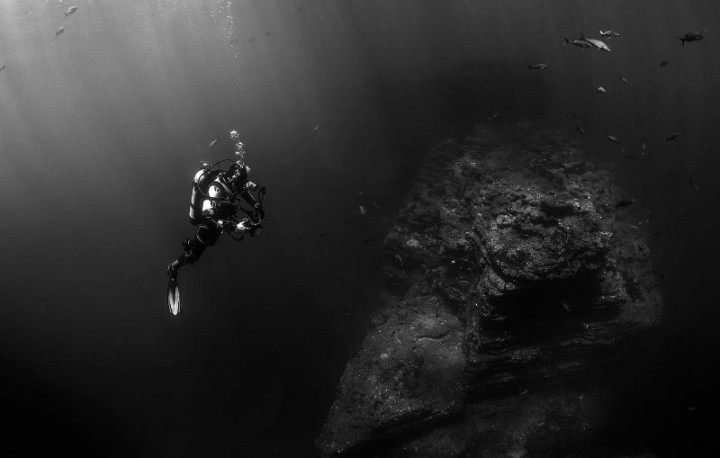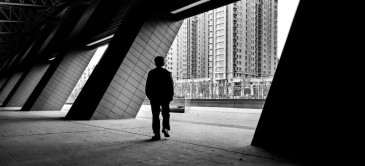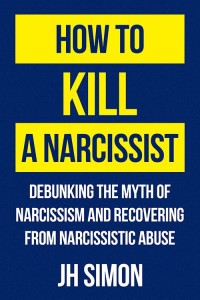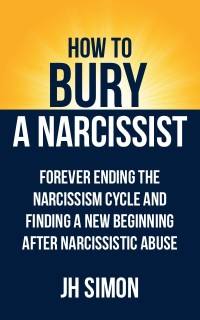The ‘false self’ is a concept which lies at the core of narcissism discourse, yet is rarely thoroughly explored. In some ways, it is as ambiguous and difficult to define as the True Self.
I’ve contemplated the false self for years, both as an idea and as it might exist in myself, which often spurs feelings of resistance. This internal pushback provides the first clue about the false self: It does not want to be exposed.
So what is the false self hiding?
To Know What Is False, Reveal What Is True
Let’s begin by considering the True Self and the Ego.
The True Self is your internal blueprint. It is your universal and ancestral potential, which is compelled to contribute to the game of evolution by expressing its energy in the world. The True Self contains your emotions, your instincts, your nature, your drives and your archetypes, such as the warrior, the diplomat, the sage and the lover. The True Self allows you to express energy in the world in fascinating forms, from the capacity to assert your strength, to your ability to lead others, to finding clever solutions to problems. Yet the True Self has no mind and no eyes. For that, it needs the ego.
The ego is your representative in the world. It analyses, judges and makes decisions aimed at what it deems to be in your best interest. The ego determines which actions will keep you safe, nurtured and prospering in life. It also alters how you interact with others, customising your personality in different contexts to better get your needs met. You might be submissive and appeasing, aiming to soften others into supporting you. You might be hard and aggressive instead, hoping to force cooperation. If you judge someone as ‘inferior’ or detrimental to your standing in society, you might grow contemptuous and detached, looking to avoid being negatively influenced by them.
When isolated, the ego seems like a cold and greedy tool of manipulation — which is precisely what it is. The ego is a tool of the mind which evolved as a needs-meeting machine. Yet a world driven by ‘machines’ leads to exploitation and ruin. Humans are motivated by much more than their basic needs. Purpose. Beauty. Meaning. Love. Belonging. Connection. Joy in being. These are just some of the authentic qualities which are beyond the ego. To function in a way that is beneficial to humanity, we need a healthy ego which allies itself with the True Self.
Harmony Within, And Without
A healthy ego aims to accurately read our inner reality i.e. the mysterious designs of our True Self, while harmonising it with outer reality i.e. what the world demands of us.
The True Self is indeed a mysterious metaphysical organism, with each person seemingly born having a unique ‘nature’. A person’s temperament is driven greatly by their True Self, along with what they are drawn towards and what resonates with them. Some people are warriors by nature, craving the challenge of conquering and shaping the world according to a higher design. Others are thinkers and philosophers, able to access hidden realms and share their discoveries for the benefit of mankind. Some are abrasive by nature, others are healers.
When a person has a regulated nervous system, has successfully attuned to their True Self, and possesses an understanding of how reality and the world work, then the True Self can better actualise. Such a person intimately knows and accepts their nature. Armed with a healthy ego, they go about negotiating their place in the world.
Unless, of course, they carry complex trauma, in which case their trajectory is vastly different.
The Wounded Ego
Developing an ego capable of guiding the True Self towards actualisation is a delicate process. It requires skilled and wise parenting.
A child begins life in an unadulterated, authentic state, with an emerging ego thirsty for knowledge. Along with explaining to the child how the world works and how to act in it, the healthy parent empowers the child’s True Self in various ways.
The healthy parent takes the time to truly see and acknowledge the child as they are — not how they prefer the child to be. The healthy parent expresses delight at the child’s presence. They also respect the child and create space for their emotions, helping them regulate their inner state. They make sure the child feels supported. The parent tells the truth and follows through on promises, and ensures the child feels safe and is never overwhelmed. Such healthy parenting allows the child to thrive in the world.
Of course, no one is perfect. Some parents act in ways that harm and traumatise the child. Life can be chaotic and destructive. War, economic hardship, tragedy, conflict and other misfortune can strike at any time. Some people are forced into parenthood before they are ready. All of this creates aggression, anger, bitterness and destructiveness, which negatively affect how a parent treats their child.
A parent might express disgust and be repulsed by their child. They may reject the child’s true feelings, wants and needs, and force the child to live up to rigid expectations. An unhealthy parent could ritually humiliate and disrespect their child. They might lie to the child, or rarely follow through on promises. When the child is feeling dysregulated, the unhealthy parent neglects and rejects them, leaving them overwhelmed and alone with their inner chaos. Betrayal and terror often plague the child of an unhealthy parent.
Such mistreatment traumatises the child and fractures their True Self. The child’s nervous system becomes excessively over-stimulated, and their body tenses like a rock to resist feeling emotions. The child dissociates from their inner experience, and is barely able to feel their body, let alone attune to their True Self. When it comes to ego development, the child grows dazed and confused, unable to make sense of anything — neither inside nor outside themselves.
Paranoia grips the traumatised child. They never feel safe, and constantly expect the worst. The world becomes a dystopian hell. Eventually, the child loses touch with their True Self, falling into a dissociated pseudo-reality. Rather than living a life of meaning and purpose through their True Self, the traumatised child is forced to bypass their authenticity altogether.
Plagued by complex trauma, the child develops core wounds brought on by the above-mentioned forms of humiliation, betrayal, abuse and neglect. Once a core wound forms, there it remains, aching and seeking a resolution that does not exist.
Yet life must go on. Meanwhile, the child’s core wounds remain repressed by denial, muscle tension and dissociation. To survive their hostile environment and resolve an untenable situation, the child conjures a new self from thin air. This new ‘self’ is a product of the child’s primitive ego. Its purpose is to numb the child’s pain, get their neglected needs met, and put their fractured Self back together. The false self has almost no awareness of the child’s inner reality, however. Rather, it carefully watches the outer world through a lens of paranoia, seeking ways to manipulate reality, hoping to create a semblance of normality.
Rather than getting real needs met, the false self aims to assuage its core wounds — which are bottomless pits of desperate yearning created by chronic abuse. Above all, the false self is a tool for justice, looking to clear the slate and compensate for what the traumatised child now ‘lacks’.
The Many Faces Of The False Self
Because a narcissist is completely cut off from their True Self, they feel dead inside. As a child, they were dehumanised and left unseen, never being acknowledged for who they truly were. Consequently, the child created a false self intended to extract energy from others (narcissistic supply), and which had to be more special and superior to others (grandiosity).
This is common knowledge, of course. Grandiosity and addiction to narcissistic supply are the two pillars of the narcissistic false self. However, a sense of aliveness and being seen are only two of the many authentic needs a human has. To better our understanding of the false self, we need to consider all of its possible core wounds and resulting compensation strategies.
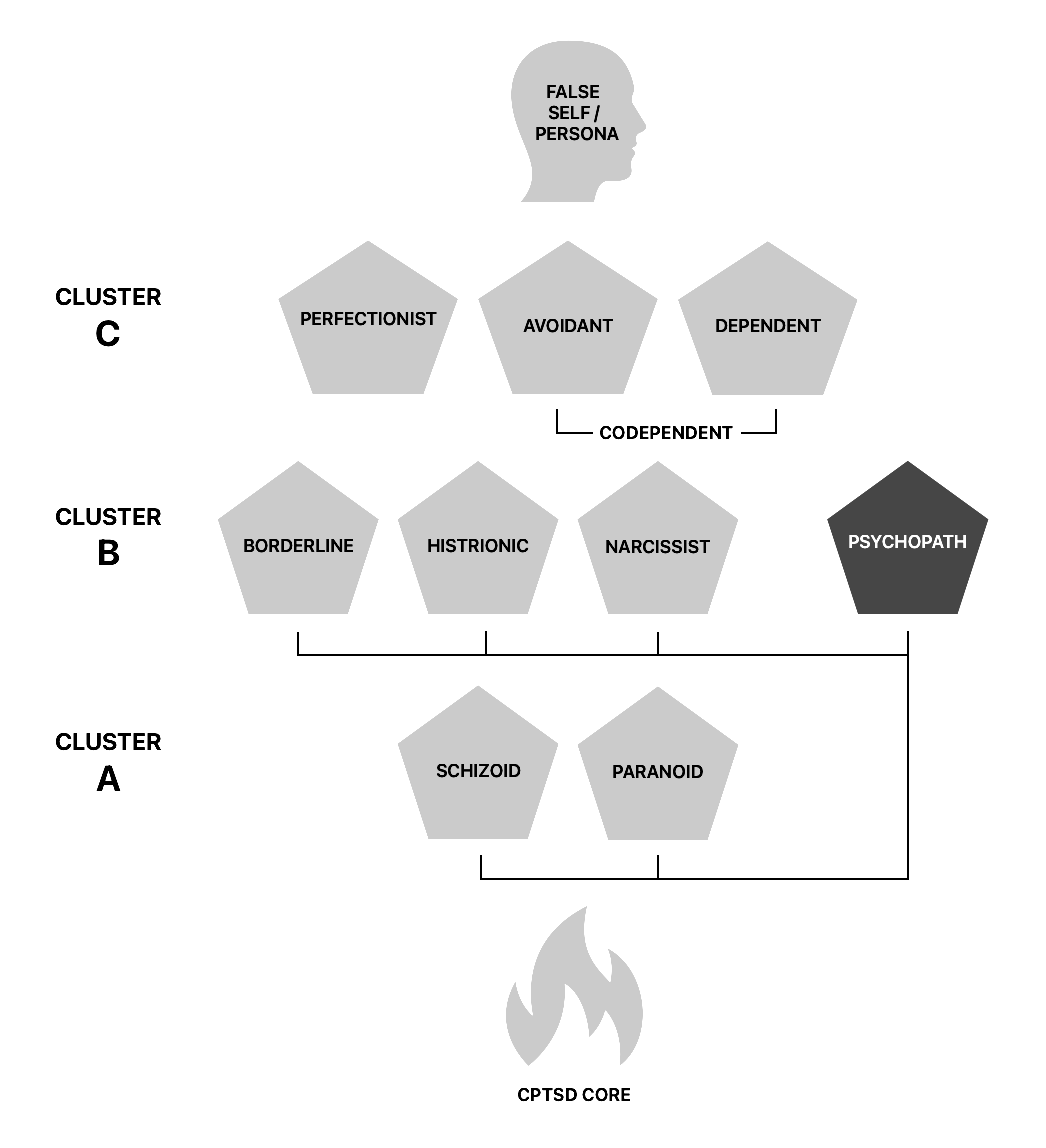
Using the Cluster A and B personality disorder maps, we can help illustrate the many forms a false self can take:
- Histrionic: Due to feeling unwanted, the histrionic seeks to be desired by all people at all times, behaving in seductive and sexual ways that court favour.
- Psychopath: Feeling chronically humiliated and disrespected, the psychopath aims to reassert control and develop a god-like status. They achieve this by manipulating and punishing people into submission — no matter the cost.
- Borderline: Left drowning in the ocean of their emotional dysregulation without support, the borderline plays the innocent person in need, seeking a rescuer or saviour to act as their emotional rock and ‘special friend’.
- Paranoid: After being constantly betrayed and lied to, the paranoid remains hyper-vigilant, never trusting the world while scanning it for threats in the hope of feeling safe.
- Schizoid: The schizoid is a result of being terrorised and overwhelmed. When the child’s negative emotions destabilise them to the point of disintegration, they ‘check out’ and stop mentally engaging the world. The schizoid ends up seeing the world through a ‘psychological window’. It is an ‘ostrich in the sand’ form of feeling secure.
The Hijacked Ego
At its core, the false self is a last-ditch attempt at reinforcing a fractured True Self. By hijacking the ego and standing in its place, the false self tricks the world into fulfilling its unholy and insatiable needs. The false self is detached from reality while putting on a mask of normalcy. Often it is the only safeguard keeping a person from falling into insanity and self-destruction.
If someone feels chronically unlovable, they may never seek out love and connection. An avalanche of betrayal and humiliation can leave you drowning in soul-crushing shame. Emotional dysregulation clouds your mind and thrusts you into psychological vertigo and madness. To feel no control over your sense of safety is unacceptable, let alone terrifying to the point of death. When your nervous system is already in the red, being unable to ‘check out’ is also a death sentence. The false self is the crudest form of surviving these untenable situations.
Therefore, rather than associating the false self purely with narcissists, we need to see it as a far more complex entity with equally complex capabilities. The confusion between the false self and True Self is equal to the question of what is real and what is not — often the line can be blurred.
Think of the True Self as an advanced form of a plant blooming. When it is fractured and traumatised, the True Self’s natural flowering process is thwarted. Its leaves and roots become mushed and scattered. Choosing not to accept such a fate, imagine this flower nonetheless attempting to bloom. The result is a tangled web of leaves and roots and stalks and flowers which are far different from a ‘normal’ specimen.
This is what it is to have a false self. The traumatised person, whether narcissist, histrionic, psychopath, borderline, schizoid, paranoid or a combination of all, is a broken flower daring nonetheless to bloom — often in defiance of reality. Such a person takes shortcuts towards ‘normalcy’, and leaves behind a trail of manipulation, confusion and pain.
The core difference to the plant analogy, however, is that the false self often appears fully formed and ‘normal’. It achieves this miracle through fantasy. When you meet someone with a false self, you get an inkling sense that something is off. Many people spot the discrepancies and walk away. Others are lured into the false self’s imaginary ‘realm’, and become enraptured by the fantasy.
The more you get to know a person, the more the false self exposes itself. Slowly but surely, you gain further clues of how such a person is defying reality in every facet of their lives. This is the case for all forms of false self. While the needs, wounds and manipulations vary between types, all of them are rooted in trauma. And having been tricked into such a distortion of reality, you are left distraught and twisted inside, needing many months to straighten out your branches, and for your flowers to bloom back to their original state.
